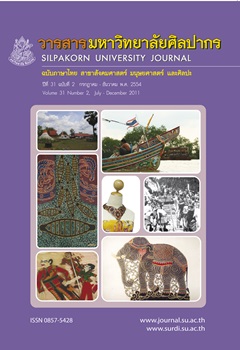ทฤษฎีความหมายในทัศนะของพัทนัม : เกณฑ์กำหนดความหมายจากภายนอก The theory of meaning in Putnam : Semantic Externalism
Main Article Content
Abstract
บทคัดย่อ
ปัญหาสำคัญประการหนึ่งในปรัชญาภาษาได้แก่ ปัญหาที่ว่าอะไรคือเกณฑ์กำหนดความหมาย เกณฑ์นั้นเกี่ยวข้องกับสภาวะจิตหรือโลกภายนอก ทฤษฎีความหมายกระแสหลัก เช่น ทฤษฎีความหมายแบบเฟรเก้ มีแนวคิดที่ว่าเกณฑ์ในการกำหนดความหมายนั้นมีความสัมพันธ์กับสภาวะจิต ซึ่งอาจเรียกได้ว่าเป็นทัศนะแบบเกณฑ์กำหนดความหมายจากภายใน ฮิลลารี่ พัทนัมโต้แย้งทัศนะดังกล่าว โดยการเสนอตัวอย่างโลกแฝดเพื่อแสดงให้เห็นว่าสภาวะจิตไม่เพียงพอแก่การกำหนดความหมาย และทัศนะนั้นยังไม่สามารถอธิบายความสัมพันธ์ระหว่างภาษากับโลกภายนอกได้ พัทนัมจึงได้เสนอแนวคิดเรื่องเกณฑ์กำหนดความจากภายนอกซึ่งอธิบายว่า ความหมายของคำหรือประโยคมีที่มาจากการใช้คำของคนในชุมชนและโลกภายนอก ได้แก่ ธรรมชาติที่แท้จริงของสิ่งต่างๆ ในโลกบทความนี้มีข้อสรุปว่า ถึงแม้ว่าแนวคิดของเรื่องเกณฑ์กำหนดความหมายจากภายนอกสามารถอธิบายความสัมพันธ์ระหว่างภาษากับโลกภายนอกได้ แต่ไม่สามารถอธิบายความสัมพันธ์ระหว่างภาษากับมนุษย์
คำสำคัญ: 1. ปรัชญาภาษา. 2. ทฤษฎีความหมาย. 3. ฮิลลารี่ พัทนัม. 4. เกณฑ์กำหนดความหมายจากภายนอก
Abstract
An important problem in the philosophy of language concerns the problem of the condition thatdetermines meaning. The question is whether the condition involves mental states or the external world. HilaryPutnam argues that a traditional view in theory of meaning, such as the Fregean theory, tends to be semanticinternalism. He raises the Twin Earth Thought experiment in order to show that meaning is determined byexternal conditions, namely, the social experts and the natural essence of things in the external world. Thisarticle concludes that although Putnam’s semantic externalism shows how language relates to the world, itcannot explain the relation of language and humans.
Keywords: 1. Philosophy of language. 2. Theory of meaning. 3. Hilary Putnam. 4. Semantic externalism


